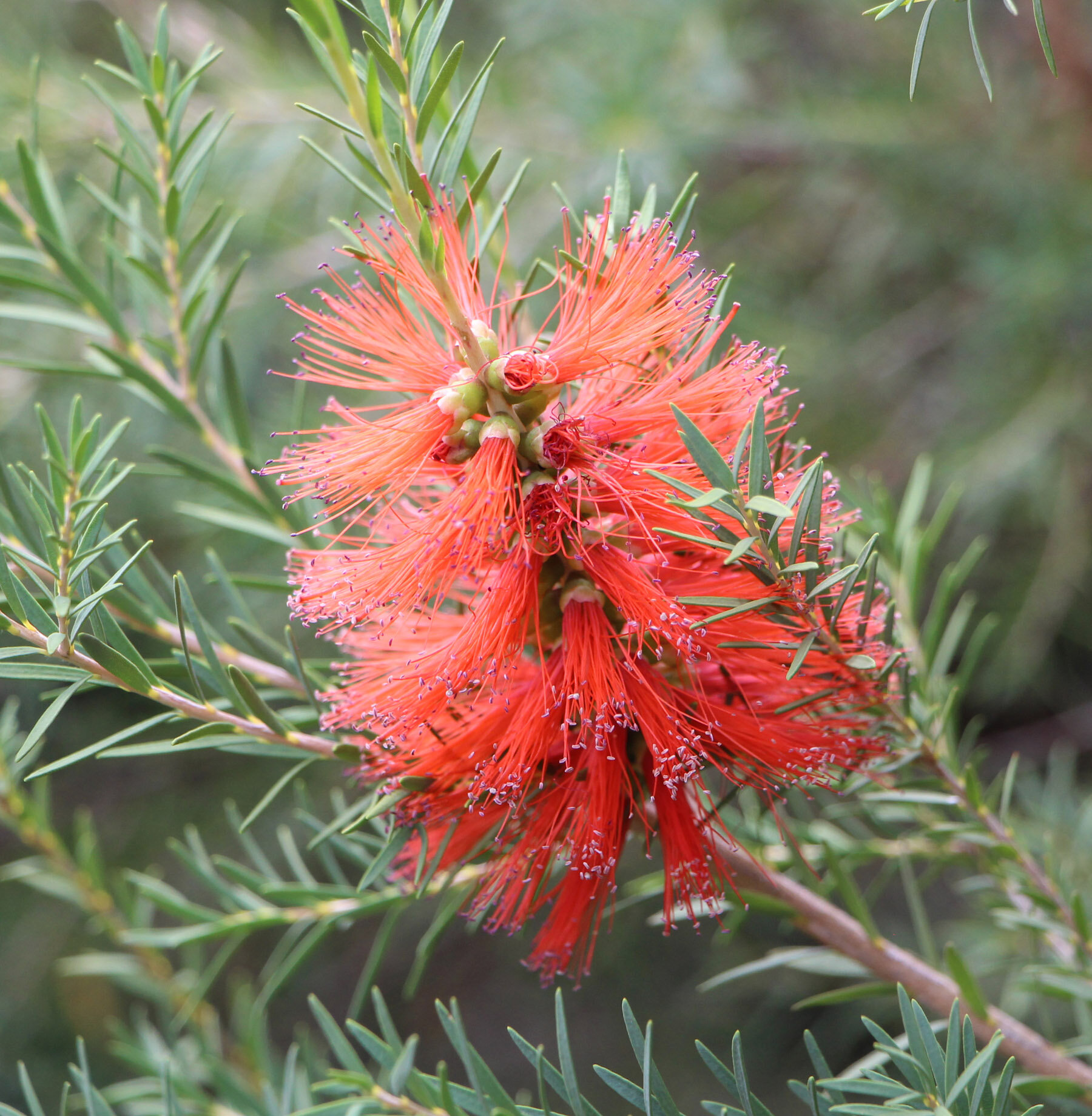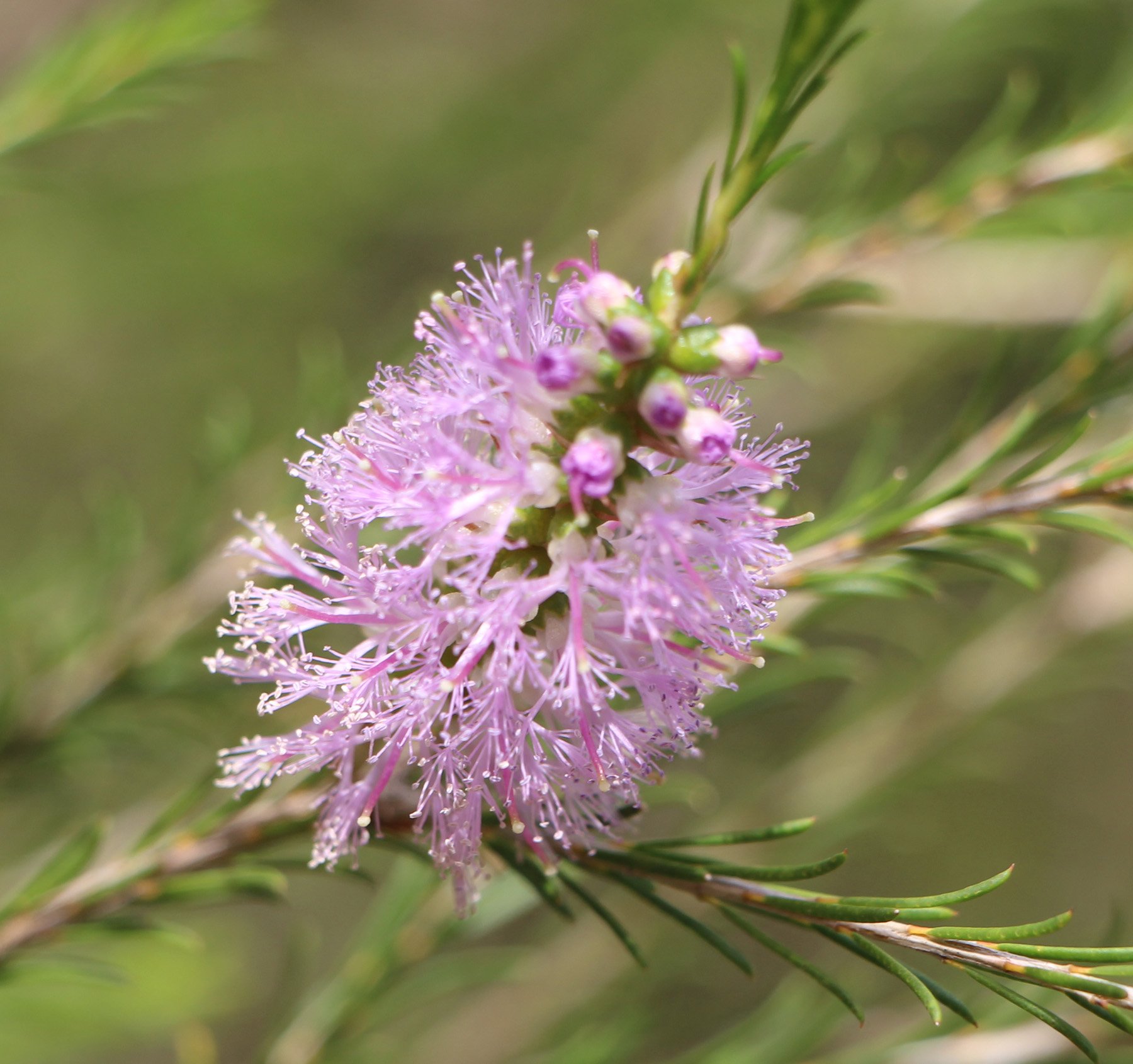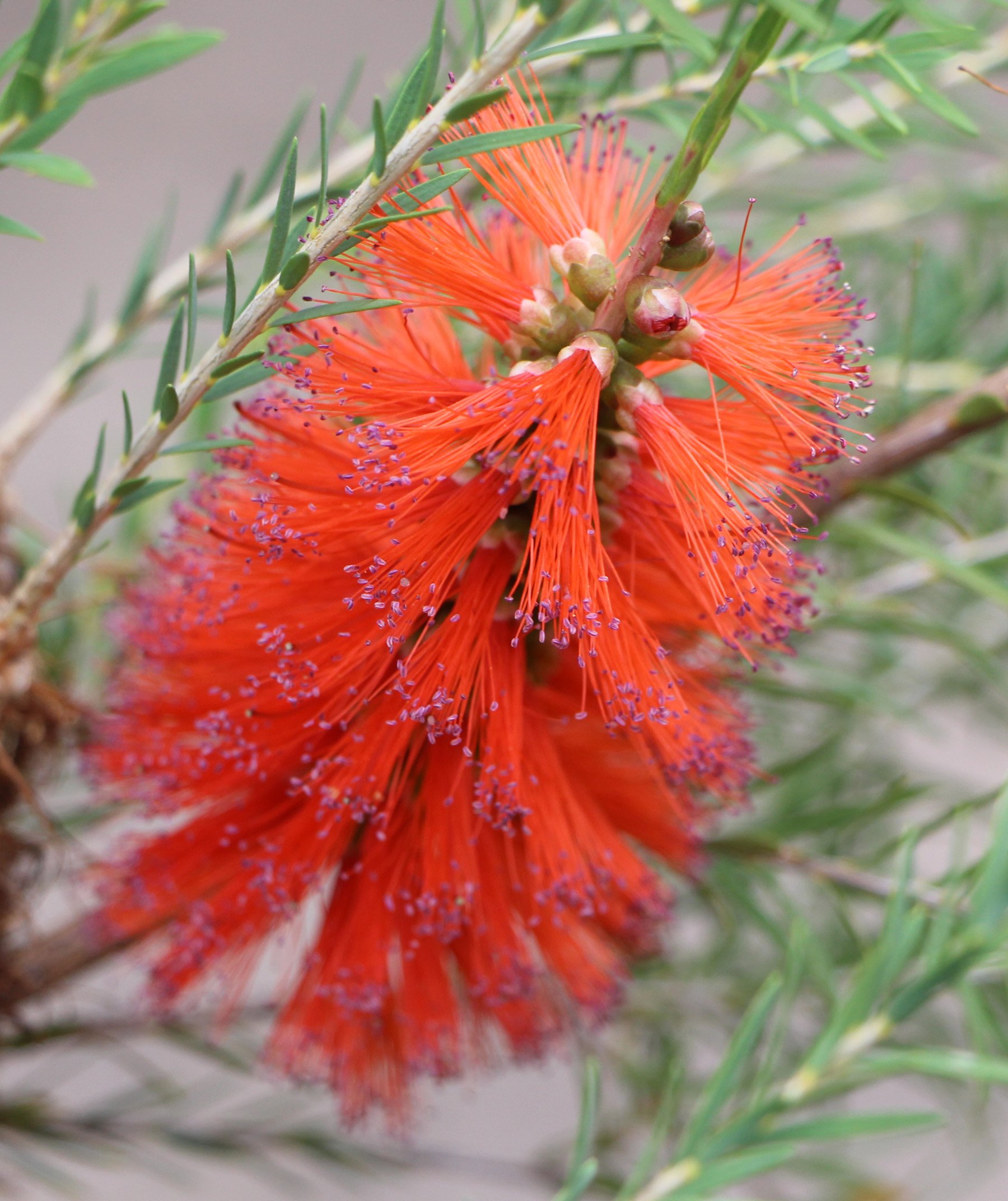Melaleucas
Melaleuca lateritia
We have planted 45 different species and cultivars of Melaleuca, 247 plants altogether, of which 145, or 59%, remain in the garden. We now grow 26 different species and cultivars of Melaleuca in May 2024.
Melaleuca armillaris nana ‘Green Globe’
We planted this dense rounded shrub, 1-2m high and wide, spherical appearance, fine dark green pine-like foliage, in March 2021. This plant is tolerant of moderate frosts.
Melaleuca blaerifolia (photo below left)
We planted two Melaleuca blaerifolia in October 2012 and another in March 2014, but these succumbed to the summer heat both in January and December 2014. I almost gave up on this plant but tried it again in March 2018 in the sand garden. Fourth time was a charm and this plant is at last doing well and has flowered for us. This species forms a small shrub 1m high x 1.5m wide with bright green, tiny foliage and white stems. The flowers are lime green with maroon buds. This plant is native to the Esperance area WA. In October 2025 a heavy limb fell off Eucalyptus polyanhemos and flattened this shrub into a pancake. We hope that it will recover in time.
Melaleuca decussata (Photo above right)
We planted Melaleuca decussata, or Cross-leaf Honey Myrtle, in April 2008. This plant forms a tall shrub with hard grey leaves and flowered for the first time for us with many mauve bottlebrush flowers in December 2010. This plant is native to Victoria and SA. We have also planted the dwarf form of this plant, which has somewhat different blue green foliage. We planted 3 in 2004 and 2 more in May 2006, but all of these were attacked by webbing caterpillar and removed in May 2008 as they were so damaged by the caterpillar. We have planted four more in April 2017 and 3 more in March 2018, which are all growing and flowering well. No caterpillar so far.
Melaleuca decussata dwarf (photos above)
We planted ten of these evergreen small shrubs with fine blue-green foliage and mauve bottle brush type flowers half in 2004-6 and half in 2017-8. Height to 1m. Many of the early plants succumbed to webbing caterpillar, but three remain and flower well.
Melaleuca densa - Lemon Honey Myrtle
We planted one of these shrubs, 1.5m high x 2m wide, frost hardy to -7 degrees, with small crowded leaves and cream flower spikes, in September 2020. This plant was eaten (by a hare?), caged, then transplanted in May 2022 to a better position.
Melaleuca diosmatifolia (photos below)
Melaleuca diosmatifolia is a shrub to 2m high and wide, but our plant has grown much taller, perhaps 3.5m high with linear dark green leaves and small mauve flower spikes. This plant is native from the Sydney area north to southeastern Queensland.
Melaleuca diosmifolia
Melaleuca diosmifolia, or Green Honey Myrtle, is a shrub to 3m high and 2m wide with small elliptical green leaves and light green flowers. We planted one of these in November 2013, but it was so brown after winter 2018 that we removed it. The other, planted in September 2014, survives under much more frost protection. This plant is native to southwestern WA.
Melaleuca eximia
We planted this upright shrub, 1.5-2.5m high x 1-1.5m wide, with very dark green foliage and brilliant scarlet bottlebrush flowers, in November 2020. This plant needs a sunny position with free draining soil. Seems to have disappeared in May 2024.
Melaleuca fulgens apricot, red and hot pink (photo below left)
We planted these shrubs, 2.5m high x 1.5m wide, with narrow curved leaves and apricot, (red and hot pink) bottlebrush flowers with golden anthers, in the ground in March 2015, and into pots in February 2020, and October 2025. The plant in the ground did not make it through winter 2015. The potted apricot shrub has lovely flowers but, so far, forms a very skimpy bush. This plant is native to southwestern Western Australia, northwestern South Australia and southwestern Northern Territory.
Melaleuca gibbosa (photo above right)
We planted Melaleuca gibbosa, or Slender Honey Myrtle, in December 2008. This plant forms a medium rounded shrub to 2.5m high and 2m wide with small ovate leaves and mauve flower spikes and is native to the coastal regions of SA, Victoria and Tasmania. We also planted one Melaleuca gibbosa ‘Pink Passion’ in November 2014 and four more in September 2018. These plants should grow to 1.5m high and 1m wide, with grey-green leaves and spectacular deep pink flowers. So far they remain small in our garden.
Melaleuca gibbosa ‘Pink Passion’ (photos above)
We planted two of these hardy shrubs, 1.5m high x 1m wide, with grey-green leaves and spectacular deep pink flowers, in 2014 and 2018. This plant grows best in full sun or part shade in an average to moist part of the garden.
Melaleuca huegelii pink form
We planted one of these shrubs, 3m high x 2-3m wide, with green overlappring leaves and small pink bottlebrush flowers, in November 2020. This plant needs an open sunny position and is tolerant of drought, frost and coastal conditions.
Melaleuca hypericifolia (photos above)
As part of our foundation planting we planted 5 Melaleuca hypericifolia, or Hillock Bush, in 2003. This plant grows to 3m high and 2.5m wide with oval foliage and somewhat weeping branches and orange red brush flowers. These plants were under the protection of an Arizona Cypress, which eventually was removed in 2005. Some of the Hillock Bushes resented being exposed to the frost and died, but two remain, despite being attacked by webbing caterpillar in November 2008. They have grown to 1.5m high and 2m wide in our garden and do not bloom well. This plant is native to the southeastern coast of NSW.
Melaleuca hypericifolia ‘Ulladulla Beacon’
We also planted two Melaleuca hypericifolia ‘Ulladulla Beacon’, a prostrate plant mounding to 30cm high and 1-2m wide. Bright green foliage and orange-red brushes make this an attractive plant, although the older one of ours was attacked by webbing caterpillar in October 2007.
Melaleuca incana
Grey Leafed Honey Myrtle is a shrub with a delightful weeping habit and pretty grey foliage. In the morning with the sun shining through wet foliage, it is ethereal. We grow it in a wet position in the garden. This plant should be tip pruned regularly, but sensitively. Removed October 2019.
Melaleuca incana ‘Velvet Cushion’
Melaleuca incana ‘Velvet Cushion’ is a medium shrub to 1.5m high and wide with dense grey green weeping foliage and yellow brush flowers. We planted two of these in November 2016 in the upper sand garden, but one succumbed to frost in winter 2018. The other persists, but is still small for us and has not flowered. Much larger now and beautiful flowers in October 2025.
Melaleuca lateritia (photos above)
Melaleuca lateritia, or Robin Redbreast Bush, is a medium shrub, supposedly 1.5m high and wide, although has grown to 2m x 2m in our garden. We planted eight of these in March 2004 on the corners of the parterres near the house. They flowered first for us in January 2005 and have continued to flower over long periods since then. The flowers are bright orange-red, almost Dayglo orange. If these shrubs start to look unsightly you can cut them back to the ground and they will reshoot and flower again in two years. Ben calls them the resurrection plant. This plant is native to southwestern coast of WA.
Melaleuca linariifolia ‘Claret Tops’ (photos above)
We planted three Melaleuca linariifolia ‘Claret Tops’ in the new sand garden in October 2015. These form a dwarf shrub to 1m high x 1.5m wide, with attractive red new growth and many white flowers. They tolerate only moderate frosts so two of the three died in winter ’16, but one remains and has grown to 1.5m high and wide and flowered first in December 2018.
Melaleuca linariifolia ‘Snow in Summer’ (photos above)
We planted one Melaleuca linariifolia ‘Snow in Summer’ in December 2003 and another in March 2004. These form a shapely, bushy tree , 6-8m high, have attractive light green foliage, white paperbark trunk and many white fluffy flowers. One of our trees grew very well but the other was not in enough sun and air and was covered in sooty mould. We opened up around this tree in October 2010, but cut it down in December 2010. Since then it has grown again and is almost as tall as the original plant.
Melaleuca micromera (photos above)
We planted one Melaleuca micromera in the back garden in April 2005 and it grew well and flowered in September 2007. Then it was flattened in a windstorm and had to b e cut back severely in January 2009. A large pine branch fell on it in January 2010 and the plant was removed. Another was planted in the same area in March 2010, but this one failed to thrive and was removed after two years. We have now planted another in February 2020 in a more sheltered area and hope that it will grow well. This plant forms a rounded shrub with twisted branches, very tiny scale-like leaves and small yellow flowers, and is native to southwestern WA.
Melaleuca ‘Narrow Ness’
Melaleuca ‘Narrow Ness’ or ‘Narrow Nessy’ is a selection of M. nesophila, 3m high x 1m wide, with dense green foliage and mauve pompom flowers. We planted one in March 2019 and could not remember where it was in the garden until it bloomed beautifully in December 2019. We promptly planted another in the same bed in November 2019 and both are doing well. Update - the new one was eaten by our resident garden hare and had to be protected in a wire cage - it is recovering. We planted three more in May 2023, but these promptly died.
Melaleuca quinquinervia ‘Miniquini’
We have planted Melaleuca quinquinervia ‘Miniquini’ in a pot in February 2020. This plant should develop into a low compact shrub, 1m x 1m, with dense foliage and cream flowers. This plant is too frost sensitive to plant in our garden. No flowers so far in May 2024.
Melaleuca stypheloides (photos above)
We planted three Melaleuca stypheloides, or Prickly Paperbark in September 2007. We certainly would not have planted three if we had first seen the magnificent M. stypheloides at the Hobart Botanic Gardens. This tree has grown to stunning height and width there, but hopefully will not grow as large for us. We lost one of these trees in the heat of January 2008, but the other two have grown to 4m high and bloom every year and are developing attractive paperbark trunks. This plant is native to coastal NSW and Queensland. Removed one in March 2024 as it was too close to the callistemon hedge.
Melaleuca teretifolia ‘Georgiana Molloy’ (photos above)
We planted Melaleuca teretifolia ‘Georgiana Molloy’ in February 2019 in the upper sand garden. This plant should grow to 2.5m, high and 1m wide, with narrow dark green foliage with bronze new growth and pink-purple flowers. So far it has grown to 1m high but has not flowered. Flowered on the stem in December 2020 and is now 2m high.
Malaleuca thymifolia ‘Pink Lace’
We planted three Melaleuca thymifolia ‘Pink Lace’ in December 2018 which should grow to 1m x 1m with pink flowers. These have not grown much for us, nor have they flowered. Two remain.
Melaleuca wilsonii (photos above)
We planted one Melaleuca wilsonii, or Wilson’s Honey Myrtle, in April 2007 and it first bloomed for us in November 2008. This plant forms an evergreen shrub to 1.5m with narrow leaves and reddish pink flowers in clusters along the stems. We had successful flowering from 2008-2014 until this plant blew over in a storm. We saw magnificent specimens of this plant on our trip to Ballarat and decided to try again in March 2018. However, this plant has not thrived so far, only being 0.3m high and has not flowered. This plant is native to southeastern South Australia and northwestern Victoria in dry, sandy soils. Now growing better and has flowered well in November 2021-22.






























